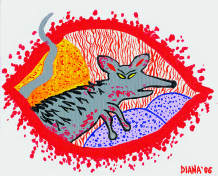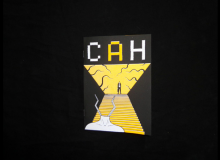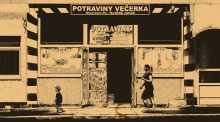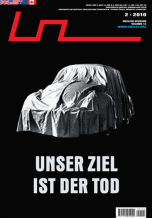|
I’m writing about Jiří Valoch because his textual installations contain a powerful poetry. His recent exhibition in the National Gallery and his work in the Caesar Gallery in Olomouc, a center of the Moravian art scene that influences him so strongly, are the best examples to consider him from. Along with Dalibor Chatrný and J.H. Kocman, he is counted among the conceptual artists in Brno; his office in that city’s House of Arts has been an important locus for concretists, conceptualists and art historians for thirty years. Here, Valoch started off preparing exhibitions for unknown and well-known artists, writing about them and visiting them. From the perspective of Prague, Moravia seems like some vast vineyard of melancholy where one goes to forget, and I can clearly recall the difference between the reaction when his name is pronounced there and here. Jiří Valoch has a surprisingly long record of activity in the art world. “The dialogue catalogue” (Dialogový catalog) of Jiří Valoch by Dagmar Lasotová, called "The Four Faces of Jiří Valoch" – a work of art published in Ostrava in 2004 for Valoch’s exhibition at the Student gallery – is a small work that shows the features of Valoch’s life and thinking, dividing him into the four faces of Artist, Critic, Curator and Collector. For someone who manages to maneuver between so many roles, he seems like a multi-headed beast hunting in every field possible. Under the pseudonym Jan Pavlík, Valoch wrote a text in his first collection of photographs, published in Italy in 1975. As a curator and collector he takes part in creating the context and as an art critic he participates in constructing the interpretative framework. He collected and critiqued the works that influenced his own works, although only marginally so. At the same time he stressed the presence of recent works with an immediate effect on him – he himself spoke about the curiosity that enables him to notice what his contemporaries are doing, while still having a lack of interest in studying art history. Throughout the years of visiting studios, working with artists, curating exhibitions and writing texts for catalogues, his collection grew; it has since been donated to the Czech National Gallery in Prague. The results of this level of activity have been the influential positions of curator, critic and collector, and the respected position of an artist who has no other critic than himself. Where he doesn’t speak about himself, his work is commented on by artists and linguists who are in a close or similar position. From the beginning of his activities in the art world, Valoch has been a co-creator and leader of the discourse about him. He draws the carriage he rides in. Ranging from visual poetry to actions, land-art works and mail art from the seventies, to concepts, poetry and textual installations from the 80s and 90s to this day, Valoch’s work is penetrated by several constants. The works are consistent with a defined space. Valoch’s works— whether they take on the form of a gallery space, a book page, a multi-page volume, a postcard or a structural form of a poem—are infused by various applications of haiku, a poem with a strictly given structure of three lines. There is also the maximum reduction of visual elements towards fields with repetitive structures. This structure was created from the spacing of the uneven letters of the typewriter in works from the sixties; later it could be found elsewhere – in the identical, consecutive sides of a page, in the formats of postcards and in the tectonics of the gallery interiors. With the onset of digital typesetting Valoch started working the semi-bold Futura typeface. A simple Sans Serif, its name refers to the Futura edition of his friend Hansjörg Meyer—a truly eternal typeface. Consistency in typography is typical of Valoch’s work: either it is the accuracy of setting the text on the page or the use of the lowercase instead of uppercase as an expression of a democratization of textual segments, something that has since become common in contemporary printing. He tends away from content and toward relations – between the seen and thought, the text and the drawing, the filled and the empty space. Valoch works conceptually by encouraging spectators to complete the work in their minds, in inner speech and imagination. When discussing the conceptual in Valoch’s work it is necessary to return to the Structuralist problems of universals. The lexical layer of Valoch’s works is ahead of his time. He even reduces nature to degrees to rasters in which he confronts uniqueness and species as in five sheets of paper entitled Statues for Gerta Pospíšilová (1973) with short Czech texts in the middle of the pages “Grass among the grass,” “a tree among trees,” “a stone among stones” “a cloud among clouds,” “lightning among lightning.” Such elementary features locate the countryside within an old Chinese picture, human beings appear only as indication of action – a touch, passing, footprints. Social reality is reflected through association with the art. Again and again the motive of transparency as a denial of the material appears, together with the motive of a memory as an instant transparency of time. An accurate analysis of Valoch’s installations’ lexical layers was done by Zbyněk Sedláček,1 who pointed to the frequent use of functional opposites. From examining of the functional qualities of the words the author moved – via the strategies of confrontation, denial and tautology - to the reflection of the existential situation. Valoch entered the art world in 1964, when he contacted pioneers of experimental poetry, Josef Hiršal and Bohumila Grögerová; He kept them up to date on the increasing interest in Concrete Poetry in Brno. He sent them his works and was published in their anthology of experimental poetry published in 1967 along with experimental and concrete poetry from Western Europe, America, Japan, Czechoslovakia and the German Democratic Republic. In the foreword by Miloš Jůzl and the afterword by the authors, one can read about the crossing of borders, about new and unexplored fields, about a pioneering art form, about a new international movement of poets, and so on. For Hiršal this so called new poetry was a program. He and Grögerová published important anthologies of poems and theoretical texts, and they conscientiously stayed in contact with people both locally and abroad. In addition to this, Hiršal became a particular historiographer of his own self and the generation associated with the "Píseň mládí" (The song of youth), a book with an experimental structure opening with memories leading to notes and notations to the notes), Vínek vzpomínek (A Bunch of memories), a book the war years and the 50s documenting in many inlaid letters, and the book "Let let" (The flight of the years), here he, together with Bohumila Grögerová, describes the sixties as an era infused with informal workshops, discussions and travels. Looking at his insights with the present day’s hindsight, art seems to have been a kind of lifestyle in that era of political liberalization without an art market. The concrete poetry appeared to create a platform for meetings and the art seemed to become a field of participation. Throughout Valoch’s life, he would only make friends with artists with whom he found agreement in artistic ideas. The mixing of personal life with art is shown in his mail art. “now art is here,” said Jiří Valoch and Gerta Pospíšilová, in English without capitals on postcards sent from Moravský kras, Berlin, Karlova Studánka and Trutnov in the 70s, thus spinning an imaginary network linking themselves with places and their addressees. In a similar manner, Valoch played up the diction of an art historian with twelve photocopies from 1973. He dedicated these to eleven artists important to him, including Ladislav Novák and J. H. Kocman. He kept the eighth for himself. The photocopies are not only a document of one of the first Xeroxes in Czechoslovakia they are also important for Valoch to communicate with foreign colleagues, particularly in the “West,” which proved fruitful (publications, exhibitions, travels...). These networks can be understood as conceptual statues of solidarity of its own kind. Valoch’s works are “intermediary” in the sense the term was used by Dick Higgins in the sixties to define the space between media used by Mallarmé and Joyce. Valoch moves from single medium and the medium of art and medium of life, but also the media of critique, curatorship, collecting and his own works. He uses all these media for the same purpose – to articulate, to share and to distribute or refine his own opinions, to create. Four or even more of his roles in the context of the contemporary art can be understood as more ways of movement which he switches on his way. In addition to aesthetics, Valoch studied Czech and German studies under Jiří Levý, an important theorist of translation and a pioneer of experimental poetry in our country. It was with Levý’s guidance that he wrote a thesis called “Experimental Poetry and its Typology”. It is worth noting how Structuralist linguistics influenced his artistic thinking. The beginning of Structuralism in linguistics concerns the way a sign in language is formed by two parts – a signifier and a signified, the denoting and the denoted. Ferdinand de Saussure, a Swiss man who came up with this theory, strictly denied that the signifier – the word and its acoustic picture or textual record – was anything more than a convention accepted by the speakers. All language signs are, according to him, random and arbitrary. This contrasted with the idealistic understanding of Plato and the Bible according to which the existing ideas of things would have single words assigned. Imitative, onomatopoeic words whose sound side is the closest to the meaning, de Saussure considered a negligible exception. Another aspect of the signifier is linearity. In the same moment there can’t be two language signs standing next to each other because the utterance is simultaneous. The third characteristic of the signifier is its discretion, incompatibility, in opposition to the sound material of the language in itself which is formless, something like a nebula just like all the content’s meta-language. A signifier is created only when a specific amount of phonemes in a specific order matches with the delimited piece of the meta-language nebula which in our brain is registered as a continuum, which has gradual transitions and continuity. With his textual works, Valoch touches on each of these characteristics of the language sign. The linearity is disrupted by counting with a parallel understanding of textual fragments. He often inserts a slash between words to show a juxtaposition of opposite or inconsistent meanings and create tension. He questions the sign’s arbitrariness because when they are removed from context, their form becomes bound more closely to the meaning, stressing their visuality. He skips discontinuity by using abstractions; it’s interesting to note the exceptional ways color can be used. Only a few works incorporate color, and usually it’s just a dab with a crayon. In his textual works he often uses names of colors, as if he fascinated by the “image” of the color. When he writes in one of his publications “green and yellow” this evokes in the recipient a strong visual feeling of some concrete, indefinable material that can be thought about but for which we have no words. *** The latest of Valoch’s texual realizations was at Prague’s Veletržní palac art museum. The work began on the first panel opposite the entrance with the letters x, y and z—the letters describing the three dimensions in geometry. It was as if he wanted to turn the attention of the viewer to the attributes of space. The exhibition was called Installation, but the dynamic relationships that were seen in the space showed that we move more or less in something similar to a theater stage set for movement. Valoch stages finished textual fragments into the space in which non-linear relations arise. One of the stage techniques is the moving forward of some texts – they are cut in a greater size of the letters (z-axis) and their movement in the vertical y-axis, as well as on the horizontal x-axis. The element putting this into motion is the viewer, whose presence adds the time dimension. Valoch has considered different ways of exhibiting an isolated word in gallery spaces since the end of the sixties, during the Communist era Normalization. After the 1989 Velvet Revolution, he realized a few dual installations, in the Olomouc gallery Pod podloubím, where he wrote on the wall in one room “yesterday” and “tomorrow” in the other one (the curator Yvonna Boháčová had to fight with the officers who wanted to close the exhibition because the custodian had nothing to guard in there), in the installation for the Sýpka gallery in Moravia, on opposite sides of the wide hall of the gallery one wall read “somewhere” and the other one “nowhere.” At the Jelení gallery in Prague he put a huge lowercase “a” in one room and in the other a huge capital “z” —a beginning and an end within few meters. When he was invited by Jan Stolín to the segmented spaces of the Gallery Die Aktualität des Schönen in Liberec a former apartment, Valoch reacted by unfurling a textual installation into many various sequences. This segmented concept was also used in the Dům umění in České Budějovice, in the Moravian gallery in Brno and in Veletržní palác. While “new poetry” was understood in the sixties to be a reaction to the devaluation of the meaning of language, today the way that Valoch’s work can be understood is as a contribution to the non-linear reading of texts that slowly but surely become a rule – the orientation in the urban space assumes a perception of texts from various levels, just like the layered texts of web pages and so on. But human memory works similarly. Valoch inhabits the space with words, with the mise-en-scène of the text from his memory, with a conglomerate of meaningful falterings, fragment of text brought over from the memory to the timelessness of the gallery, into the permanent presence, and in this he is more personal than ever. Boldly challenging readers to DO IT YOURSELF! Valoch published a book entitled “Poems by Jiří Valoch and ...............” Inside under prescribed names and genres of the poems, such as “Haiku on an Unknown River” an empty space beckoned the reader’s participation. Similarly participative were his actions with land art, mail art and his present day textual installations. In school, poems are taught using the unfortunate skill of unlocking their poetic language to find hidden messages; but more than an encoded record for the informed, every poem is a space for communicating. It is modeled by words and their visual dimensions are where experience is transmitted. Valoch would use the word “situation,” which reflects the dynamic relations his poems create and the more important meaning – that the “situation” is happening “now.” At the beginning of the sixties Valoch experimented with repetitive letter structures, in the seventies and eighties he examined the possibilities of a bunch of sheets – he created books, notebooks of sheets of typewriter writings stuck together in grayish folders. Even though they’re ready, they still wait for publication. (The only poetic publication of Valoch’s in our country is Kytička of more or less accurate haiku, which was put out by the publishing house Vetus Via in Brno in 2004.) In his latest work Valoch transforms the gallery interiors into a poetic architecture or landscape that one can walk through and cloak oneself in; it is impossible not to experience the work, because it is difficult to hide one’s eyes from it. “The Landscapes of Language” (Krajiny jazyka) is the name of Valoch’s poem from a book in modo classico from the years 1986 and 1987. Although he works with visuality, he never uses “visual language,” but simply words whose reception is switched on automatically and which are understandable to everyone. The material existence of the text in the gallery space starts the inner dialogue of the viewer. If literary theory speaks of the lyrical subject as located in the center of the utterance of each poem, in Valoch’s textual installations, everyone becomes just that. Valoch’s works are so present in the most elementary sense of the word, because they are lived in the present.
Рекомендуемые статьи

|
|
There’s 130 kilos of fat, muscles, brain & raw power on the Serbian contemporary art scene, all molded together into a 175-cm tall, 44-year-old body. It’s owner is known by a countless number of different names, including Bamboo, Mexican, Groom, Big Pain in the Ass, but most of all he’s known as MICROBE!… Hero of the losers, fighter for the rights of the dispossessed, folk artist, entertainer…
|

|
|
Contents of the new issue.
|

|
|
There is nothing that has not already been done in culture, squeezed or pulled inside out, blown to dust. Classical culture today is made by scum. Those working in the fine arts who make paintings are called artists. Otherwise in the backwaters and marshlands the rest of the artists are lost in search of new and ever surprising methods. They must be earthbound, casual, political, managerial,…
|
|



































 New book by I.M.Jirous in English at our online bookshop.
New book by I.M.Jirous in English at our online bookshop.
Комментарии
Статья не была прокомментированаДобавить новый комментарий